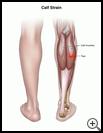
Calf Strain: Teen Version
________________________________________________________________________
KEY POINTS
- A calf strain is a stretch or tear of a muscle or tendon in the back of your leg below your knee. Tendons are strong bands of tissue that attach muscle to bone.
- Change or stop doing the activities that cause pain until the injury heals.
- Strains can be treated with moist heat, ice, medicine, an elastic or neoprene sleeve around your calf, and sometimes physical therapy.
________________________________________________________________________
What is a calf strain?
A calf strain is a stretch or tear of a muscle or tendon in the back of your leg below your knee. This area of your leg is called the calf. Tendons are strong bands of tissue that attach muscle to bone.
This type of injury is often called a pulled muscle.
What is the cause?
You can strain your calf muscle when you do an activity that involves pushing off forcefully from your toes. For example, it may happen when you are running, jumping, or lunging.
What are the symptoms?
Symptoms may include:
- A snapping or popping sound at the time of the injury
- Pain or burning in the back of your lower leg
- A feeling that someone has hit you in the back of the leg
- Trouble rising up on your toes
- Swelling and bruising
How is it diagnosed?
Your healthcare provider will ask about your symptoms, activities, and medical history and examine your leg.
How is it treated?
You will need to change or stop doing the activities that cause pain until your muscle or tendon has healed. For example, you may need to swim instead of run. You may need to use crutches if it’s too painful to walk.
Your healthcare provider may recommend stretching and strengthening exercises. Your provider may refer you to physical therapy.
Your healthcare provider or physical therapist may tape the injured muscle while it heals to help you return to athletic activities. Taping helps reduce movement that may cause more muscle damage. They may recommend wearing an elastic or neoprene sleeve around your calf.
A mild strain may heal within a few weeks. A more severe strain may take 6 weeks or longer to heal.
How can I take care of myself?
To help relieve swelling and pain:
- Put an ice pack, gel pack, or package of frozen vegetables wrapped in a cloth on the sore area every 3 to 4 hours for up to 20 minutes at a time.
- Do ice massage. To do this, freeze water in a Styrofoam cup, then peel the top of the cup away to expose the ice. Hold the bottom of the cup and rub the ice over the painful area for 5 to 10 minutes. Do this several times a day while you have pain.
- Keep your leg up on pillows so that it is above the level of your heart when you sit or lie down.
- Take nonprescription pain medicine, such as acetaminophen, ibuprofen, or naproxen. Read the label and take as directed. Unless recommended by your healthcare provider, you should not take these medicines for more than 10 days.
- Nonsteroidal anti-inflammatory medicines (NSAIDs), such as ibuprofen, naproxen, and aspirin, may cause stomach bleeding and other problems. These risks increase with age.
- Acetaminophen may cause liver damage or other problems. Unless recommended by your provider, don't take more than 3000 milligrams (mg) in 24 hours. To make sure you don’t take too much, check other medicines you take to see if they also contain acetaminophen. Avoid drinking alcohol while taking this medicine.
- Put moist heat on the sore area for 10 to 15 minutes before you do warm-up and stretching exercises. Moist heat may help relax your muscles. Moist heat includes heat patches or moist heating pads that you can buy at most drugstores, a warm wet washcloth, or a hot shower. To prevent burns to your skin, follow directions on the package and do not lie on any type of hot pad. Don’t use heat if you have swelling.
Use an elastic bandage or neoprene support when you return to your activities as directed by your provider.
Follow your healthcare provider's instructions, including any exercises recommended by your provider. Ask your provider:
- How long it will take to recover
- If there are activities you should avoid and when you can return to your normal activities
- How to take care of yourself at home
- What symptoms or problems you should watch for and what to do if you have them
Make sure you know when you should come back for a checkup. Keep all appointments for provider visits or tests.
How can I help prevent a calf strain?
Warm-up exercises and stretching before activities can help prevent injuries. This is especially important if you are doing jumping or sprinting sports.
Last modified: 2016-09-01
Last reviewed: 2017-06-26

